With Arcturus as our touchstone, we set off in a virtual time machine to visit the sky of the distant future.
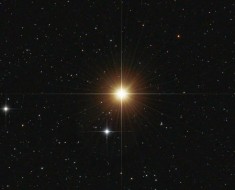
Greg Parker
Bright orange Arcturus twinkles high in the southeastern sky at dusk this week. Its slow climb from the northeastern horizon every March heralds the arrival of spring. Earth's revolution around the Sun ensures that Arcturus follows a familiar path year after year.
But hidden within in its apparent motion across the sky is Arcturus's own intrinsic or proper motion of 2.3″ to the southwest (PA 209°) each year. This very tiny amount amounts to just 1⁄800 the diameter of the Full Moon. Even over an 80-year lifetime you'd never notice the star's movement with the naked eye. That's why we have telescopes.
Over time, those arcseconds add up. If you were to make a careful drawing or take a photograph of the star when you were 20 years old and then redraw its position say 40 years later, Arcturus would have moved 92″ or about 1⁄20 the Moon's diameter, a distance obvious even at low magnification. Advice to young readers: get crackin'!
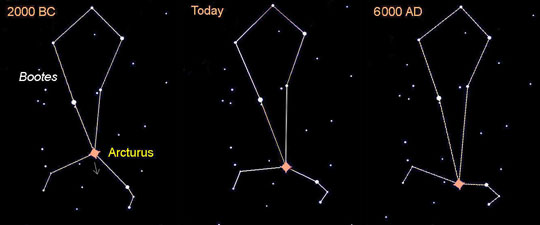
Chris Marriott's SkyMap
Arcturus stands out among its fellow stars because it's moving rapidly in relation to the Sun as well as perpendicular to the galactic plane in which the Sun revolves. I've included a map showing its gradual drift southward at the breathtaking velocity of 122 km/s (the Sun travels at 30 km/s).
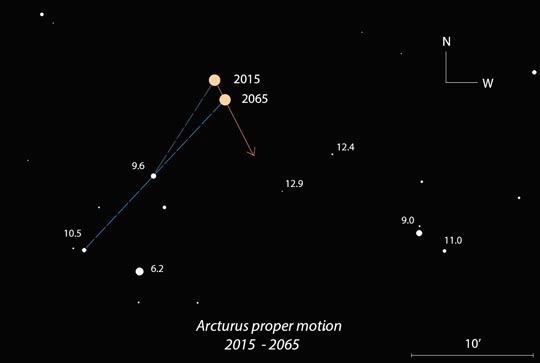
Chris Marriott's SkyMap
I like to imagine taking an after-dinner stroll with the Greek astronomer Hipparchus, who lived in the 2nd century BC. Among his many accomplishments were the compilation of the first detailed star catalog and the invention of the magnitude system to quantify star brightness. Keen observer that he was, I've no doubt he'd notice something amiss with the outline of Boötes with Arcturus having moved 1.2° southwest since his time.
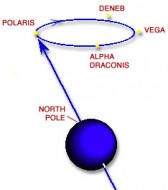
NASA
I've always loved time travel ever since seeing the movie The Time Machine as a kid. Astronomers using telescopes on the ground and in space (the Hipparcos satellite, of course!) have now measured the proper motions of many stars. Incorporated into commonly available software programs like Stellarium, The Sky, and others, they let us see the skies of the past, present, and future with a few clicks of the mouse.
Care to jump in my time machine for a look at what's ahead? I've chosen the year 27,800 AD because that's when precession of the Earth's axis will return Polaris to its seat near the North Celestial Pole. Precession, caused by torque produced by the Sun's and Moon's gravity on Earth's equatorial bulge, causes our spin axis to describe a circle in the sky with a period of about 26,000 years. In 3000 BC it pointed at Thuban in Draco; 12,000 years from now Vega will reign as polestar.
Constellations shift shape only slowly but given a precessional kick in the pants, we'd notice striking changes in 26,000 years. More distant stars like Spica will have budged just a little, while Arcturus and others practically leap across the sky.
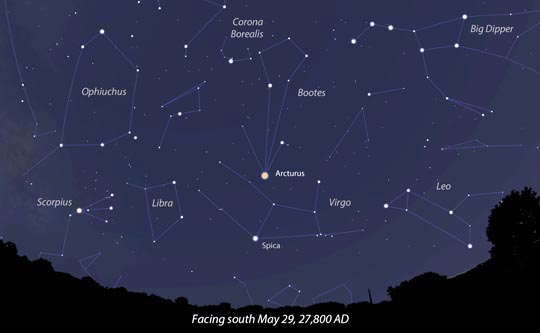
Stellarium
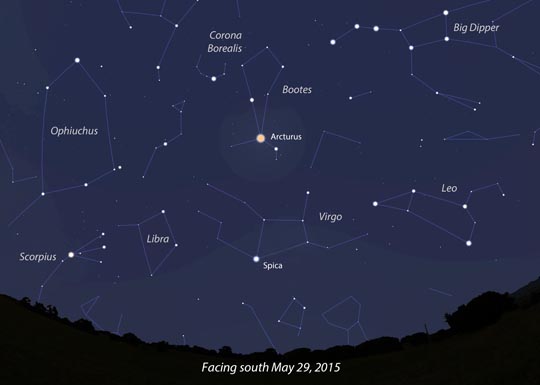
Stellarium
Overall, much of the sky would still look familiar, but with lots of Dali-esque twisting and stretching. Good examples of slightly mangled groups include Ursa Minor, Bootes, Virgo, and the Big Dipper asterism. Others like Cassiopeia might go unrecognized were it not for it location near figures less altered by time.
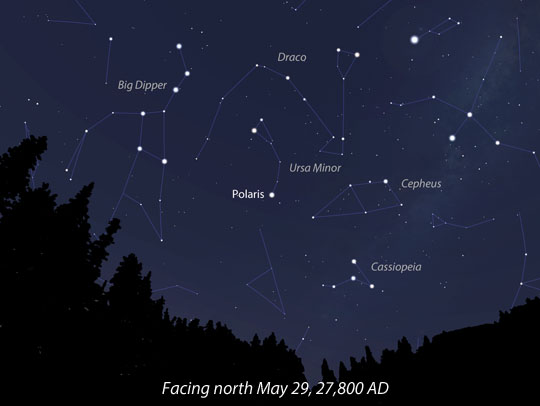
Stellarium
Star distances and hence magnitudes will likewise have changed. Arcturus is closest to Earth now but will be farther and fainter in the year 27,800.
I hope your enjoyed our brief foray into the future. Stop back next week, when I'll provide maps and details on finding and tracking two special stars that move so fast, you'll only need a year or two to catch them at their game.
Need to know what the sky looks like right now? The Sky & Telescope planisphere will show you what's up!
 14
14
Comments
Denny
May 27, 2015 at 12:58 pm
Good to know that using the Big Dipper's handle to "arc to Arcturus and spike to Spica" will still work 🙂
You must be logged in to post a comment.
Bob KingPost Author
May 30, 2015 at 3:56 pm
Denny-Payne,
Time tested if there ever was! Thanks for pointing that out.
You must be logged in to post a comment.
Anthony Barreiro
May 27, 2015 at 6:34 pm
Thanks Bob. It is fascinating to consider how the stars move through space, time, and the sky -- truly mind expanding, and a great way to connect with our ancestors and our hoped-for descendants. Arcturus is one of my favorite stars, because he's not from our part of the galaxy, just passing through like a character in a Sergio Leone spaghetti western. Because of Arcturus' high proper motion, the 2000 BCE outline of Bootes looks a bit more like a human figure than he looks today, although even back then the Herdsman was already pretty bow-legged.
By the way, does S&T have an editorial policy on the use of AD/BC vs. CE/BCE? It seems more respectful of the diverse belief systems of your readers to refer to the "Common Era" and "Before the Common Era" than to the "Year of Our Lord" and "Before Christ".
You must be logged in to post a comment.
Bob KingPost Author
May 27, 2015 at 11:38 pm
Hi Anthony,
I'm not aware of a policy, but since the date was not changed during the editing process, I assume it's acceptable. I understand your point however.
You must be logged in to post a comment.
May 29, 2015 at 4:29 pm
Should we not also change the name 'America' however, in order to be more respectful to the preceding inhabitants? Or is it only Christians who need to change their ways?
You must be logged in to post a comment.
Bill-Rudersdorf
May 29, 2015 at 8:46 pm
No one has to change their ways, just keep writing A.D. after the date on your checks like you always have.
You must be logged in to post a comment.
Michael-Swanson
June 1, 2015 at 9:42 am
goodricke1,
I so agree with you, my friend. It seems in today's world, little reverence remains for Jesus, as if the other religions of the world were somehow superior, or at the very least, equal to Christianity. And sadly, in the scientific community, and despite the intellectual and scientific mind scrutinizing a chosen subject that should point to intelligent design and a Creator, this fact is largely overlooked or ignored. I know someone will likely criticize me for my mini-rant here, but I feel I needed to chime in with you, goodricke1, because I see what you see. Only Christians seem to be asked to accommodate everyone else rather than vice-versa. "Progressive-ism" is actually regressive in my view. How anyone who observes the heavens, much less having gained the knowledge we have about our universe today, can deny that a Creator made it is simply unfathomable to me.
You must be logged in to post a comment.
GRKohler
May 29, 2015 at 6:11 pm
Hmm, what was the "Common Era" based on?
And common to whom?
You must be logged in to post a comment.
William David-Halbert
May 30, 2015 at 7:22 am
Funny that one could be offended by using BC/AD as a time label but not by the labeling of constellations using the names of older gods from ancient Greek Roman religions? Or is it really that Christians are being singled out?
You must be logged in to post a comment.
Warren-Odom
May 30, 2015 at 7:15 pm
In all my years (decades) of reading S&T, they've always used BC and AD. But what's the problem? Quoting CE instead of AD still points to (the one known as) Christ, because that's still the zero point. (Except for the little error that was made in estimating his birth year of course.) Changing would be pointless -- just saying the same thing a different way. If I should happen sometime to be quoting years according to the Jewish or Muslim calendars, I would of course use their own terminology instead of trying to invent my own.
You must be logged in to post a comment.
Peter Rowen
May 31, 2015 at 6:03 pm
Presumably, by 27800, you'll be able to see those stars' positions move even more by traveling to them.
You must be logged in to post a comment.
Michael-Swanson
June 1, 2015 at 9:49 am
Fascinating article. I remember in grade school, oh-so-many years ago, some astronomy books included a diagram of how the Big Dipper once appeared thousands of years ago, today, and how it will appear thousands of years in the future based on direction and velocity of star motions. This concept, coupled with how the night sky would appear from a planet orbiting Alpha Centauri, Sirius, Vega, or Arcturus is also mysterious to me. Actually, it is surprising that most of the constellations are still recognizable this many years hence. One thing we shall never see in this lifetime, sadly, due to precession, the joy of seeing the Southern Cross from mid-northern latitude America. That would be awesome!
You must be logged in to post a comment.
Anthony Barreiro
June 1, 2015 at 6:38 pm
I meant no offense to Christians, nor anyone else. I was just asking about S&T's editorial style. Many years ago I worked as a copy editor, and these sorts of things still interest me. I'm sorry to have upset people and diverted the discussion from this very interesting topic!
You must be logged in to post a comment.
Antonio Mario
June 5, 2015 at 3:45 pm
Bob,
Thanks for a very interesting article indeed.
A minor point, if I may. In comparing Arcturus velocity to that of the Sun, you quote 30 km/s for the latter's. Even this value sounds a bit on the large side; the motion of the Sun wrt the Local Standard of Rest is more like 17 km/s or so. Did you have some other velocity in mind?
Thanks!
You must be logged in to post a comment.
You must be logged in to post a comment.